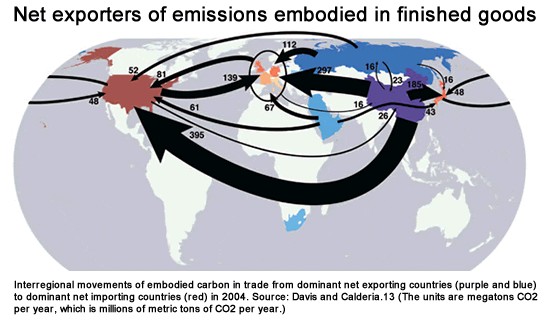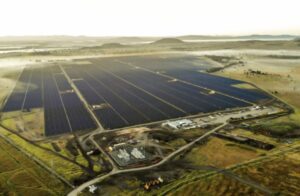One of the most infuriating things about reading advice for people wanting to reduce their carbon footprint is the colossal lack of perspective people some folk have when it comes to cutting emissions.
There’s people unplugging their phone chargers but not their DVRs. Worrying about where their food comes from, rather than what type of food it is. Or recycling their plastic bags rather than just getting some reusables.
You see, perspective is quite important if you want to make sensible decisions.
The lifecycle emissions of solar panels
There’s a really interesting new study out that compares the carbon footprint of solar panels manufactured in Europe and China.
The basic result shows that because Chinese manufacturing is less energy efficient, and reliant on coal fired electricity, the Chinese panels have a bigger carbon footprint. In fact the footprint of Chinese panels is double that of European ones, as you can see in chart from the study below.
Looking at this graph it is tempting to think that we should all be buying European (RER) solar panels rather than Chinese (CN) ones. Or that ‘you’d better buy locally‘ like with your vegetables. That’s certainly the message I’ve seen in how this paper was covered around the web.
And you know what, the local vegetable analogy is perfect. Because if you focus on food miles you’re only looking 10% of the total foodprint. And with solar panels their origin is even less significant.
Let’s get some perspective.
Where are your solar panels going?
When it comes to carbon emissions the most important factor about solar panels is not where they are made but where they are deployed.
If the solar electricity they product displaces coal fired electricity it will save 30 times the extra footprint of Chinese panels, 14 fold that difference if they displaces natural gas, and nothing at all if it displaces hydro or nuclear.
Looking at the data above the estimates for multicrystalline silicon are about 32g CO2-e/kWh for European panels and 68g for Chinese panels. For some proper perspective lets compare these two to the average carbon intensity of consumed grid electricity.
Can you see the solar panel emissions? They are the lines down at the bottom (click to enlarge). The 36 g difference between Chinese and European panels is a drop in the ocean.
I find it baffling that anyone could worry about where their panel comes from without first thinking about what electricity their solar will displace. This graph shows the average grid intensity, which although it is a good guide doesn’t always tell you the full story.
In coal heavy places solar does tend to eat into coal emissions, like it has done in Australia. But if the grid is more mixed if often displaces the sources with high marginal costs and greater flexibility, so for example in Germany it has largely impacted natural gas. Lastly if you live somewhere with a huge hydro resource (Brazil) or nuclear dominance (France) the carbon benefit of solar is minimal.
Carbon tariffs on solar panels? Seriously?
As a bit of a carbon wonk I quite liked the European vs Chinese solar panel study. I always enjoy an interesting lifecycle analysis. But one of the conclusions left me cold. Here it is:
We propose a break-even carbon tariff model for the international trade of silicon-based PV modules, indicating an appropriate carbon tariff in the range of €105–€129/ton CO2.
Don’t get me wrong I see how you could jump to proposing a carbon tariff, particularly given some of the solar panel dumping China has been doing, but surely the authors must appreciate the colossal irony of a imposing a carbon tariff just on solar panels?
For a quarter of a century Europe and the US have been outsourcing heavy industry (an its emissions) to China. The result is the Europe’s consumption footprint is 20% bigger than its terrestrial emissions, while for the US it is 10% larger. In China’s is 21% less, because a quarter of its emissions result from producing the world’s stuff.
Look at the map below from Consumption based accounting of CO2 Emissions by Steve Davis and Ken Caldeira showing the net export of emissions embodied in products.
Given that Europe has a net carbon debt to China of 300 Mt CO2 each year, while for the US this figure 400 Mt CO2, the idea that we should put a carbon tariff on just a few megatonnes of solar panel emissions is pretty surreal. I’m all all for a global carbon tax, but one just for solar panels is a lot more about protectionism than it is about environmentalism.
We can’t spend decades filling our homes with cheap goods made in China, from cheap labor and un-taxed dirty energy, and then decide we need a carbon tariff just for solar panels (a technology that helps to cut carbon).
Let’s take a look at what solar power looks like in the real world.
The solar boom is Made in China
In my endless reading of energy and environment blogs there is no subject that people get more excited about the beginning of the solar boom we have seen in recent years.
Again and again I see people using this remarkable ‘Swanson Effect’ chart from my old colleagues at BNEF to explain whats going on (this is the first time I’ve used it as I prefer to look at total system cost).
Due to this incredible drop in prices the installed capacity of solar has increased more than ten fold in the last 6 years. Why is solar so cheap you ask? Why are all your electronics so cheap? China.
In the graph below I show the world’s top 10 solar manufacturers for 2013. The ones in red have the majority of their manufacturing based in China.
That’s right. Seven of the world’s top 10 solar manufacturers are based in China. Sharp and Kyocera are in Japan, while First Solar was in Ohio and Malaysia last time I looked. There are no Europeans in the Top 10, the REC Group is its leader at 14th.
The beginning of the solar boom we are seeing at the moment may have started in Germany, but it’s made in China. Without cheap Chinese panels a great share of current installation simply wouldn’t exist and few people would be getting so excited about solar. If you wan’t to buy something European then grab yourself a quality inverter from SMA, Xantrex or PowerOne.
And remember, with some horribly bastardized words from the wondrous Ella Fitzgerald:
It’s not where your solar panels came from that matters, it’s where they are going that counts
Source: Shrink That Footprint. Reproduced with permission.












